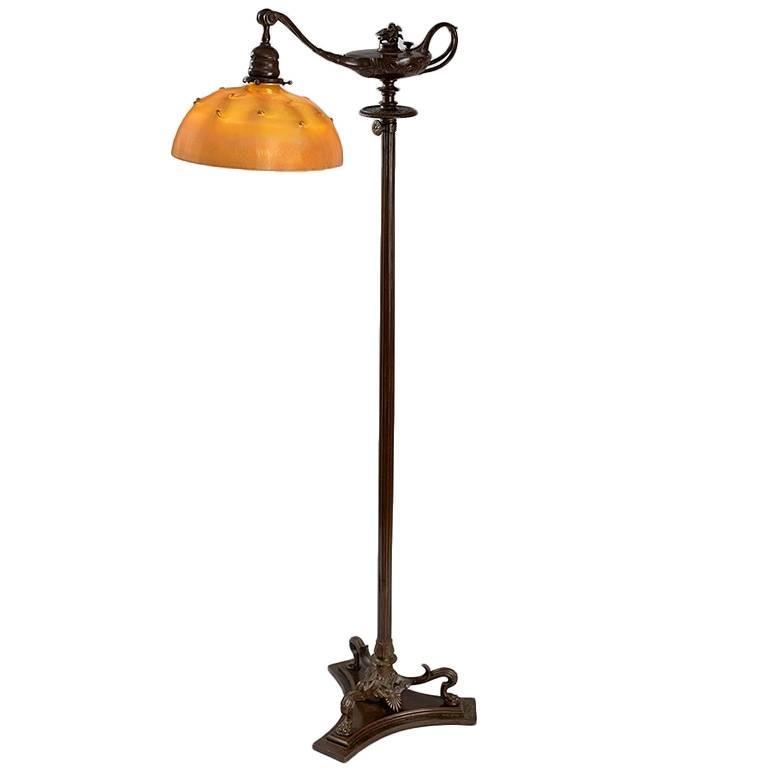Long Description: This floor lamp's arm is designed in the shape of Aladdin's lamp capable of a full 360 turn and supports the Favrile shade. The cover is decorated with a figure of an angel holding a bird. The stem is adjustable from 50" to 60" and is supported by three curved legs and a triangular platform decorated with wing motifs.
Dimensions: 60" High
References: Neustadt 31
History: Louis Comfort Tiffany (1848-1933) was born into the family known for their famous jewelry firm, Tiffany & Co. However, Tiffany decided to study art and began his artistic career when he was twenty, focusing on painting. After studying abroad in Paris, Spain, and other parts of Europe, Tiffany returned to New York to continue his art in oils and water colors. These years of his life dedicated to art served as a basis for his next exploration in interior decorating and architecture.
Tiffany started his own firm in 1881, Louis C. Tiffany & Associated Artists, which was the first of several agencies and partnerships he formed. He designed and decorated elaborate churches, theaters, houses and apartments including the Madison Square Theatre, the Church of the Divine Paternity, and the houses of Mark Twain, the Vanderbilts, and the Havemeyers. Tiffany eventually broke from the current Victorian Rococo style and developed his own Art Nouveau style after travelling to Europe. Tiffany focused on colorful designs based on free-flowing natural objects which led to his fascination in refractive effects.
Tiffany formed the Tiffany Glass Company which was absorbed in 1892 by the Tiffany Glass and Decorating Company which operated until 1900 when the Tiffany Studios emerged. Tiffany acquired patents on iridescent glass in 1881 and Favrile Glass in 1894. Tiffany's polychromatic glass allowed him to transform paintings into glass mosaics with lifelike tones. Tiffany's glass windows decorate a myriad of distinguished churches, theaters, and homes including the Russell Sage Memorial and the Tiffany Chapel. The remaining glass fragments from these windows and mosaics resulted in Tiffany's colored glass lamp shades. The first lamp shades made of Tiffany's glass appeared on the market in 1895. In addition to the leaded glass lamp shades made entirely of small glass pieces, other Tiffany shades were made from a single piece of glass blown into the desired shape. Tiffany Studios also manufactured decorative metal objects including trays, candlesticks, clocks, and similar pieces.
Tiffany used his experience in interior decorating, architecture, and landscaping on his estate, Laurelton Hall. This elaborate property consisted of a mansion with a chapel, studio, and art gallery surrounded by lavish waterfalls, stables, and gardens over 500 acres. After serving as Tiffany's estimated two million residence and focal point for his publicity, it unfortunately burnt down in 1935, two years after Tiffany passed away. Even after an original dispute with his father over his career choice in the arts, Tiffany successfully became known for his own creative designs. As the era of Art Nouveau faded, Tiffany's creations remain a cornerstone in the history of American art.
Tiffany formed the Tiffany Glass Company which was absorbed in 1892 by the Tiffany Glass and Decorating Company which operated until 1900 when the Tiffany Studios emerged. Tiffany acquired patents on iridescent glass in 1881 and Favrile Glass in 1894. Tiffany's polychromatic glass allowed him to transform paintings into glass mosaics with lifelike tones. Tiffany's glass windows decorate a myriad of distinguished churches, theaters, and homes including the Russell Sage Memorial and the Tiffany Chapel. The remaining glass fragments from these windows and mosaics resulted in Tiffany's colored glass lamp shades. The first lamp shades made of Tiffany's glass appeared on the market in 1895. In addition to the leaded glass lamp shades made entirely of small glass pieces, other Tiffany shades were made from a single piece of glass blown into the desired shape. Tiffany Studios also manufactured decorative metal objects including trays, candlesticks, clocks, and similar pieces.
Tiffany used his experience in interior decorating, architecture, and landscaping on his estate, Laurelton Hall. This elaborate property consisted of a mansion with a chapel, studio, and art gallery surrounded by lavish waterfalls, stables, and gardens over 500 acres. After serving as Tiffany's estimated two million residence and focal point for his publicity, it unfortunately burnt down in 1935, two years after Tiffany passed away. Even after an original dispute with his father over his career choice in the arts, Tiffany successfully became known for his own creative designs. As the era of Art Nouveau faded, Tiffany's creations remain a cornerstone in the history of American art.
Item created by: nmwhite997 on 2016-08-08 12:56:00
If you see errors or missing data in this entry, please feel free to log in and edit it. Anyone with a Gmail account can log in instantly.
If you see errors or missing data in this entry, please feel free to log in and edit it. Anyone with a Gmail account can log in instantly.







